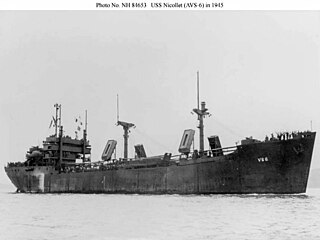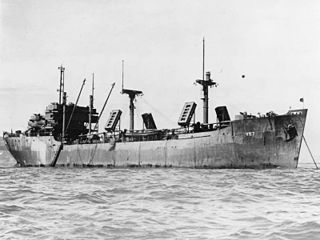Service history
Between 16 June and 1 September 1945, Faribault voyaged from San Francisco, California, to Leyte and Eniwetok with cargo, then sailed again 29 September with cargo for use in the occupation of Japan.
She remained in the western Pacific Ocean, carrying cargo to and from Yokosuka, Guam, Saipan, Okinawa, Luzon, Samar, and Manus Island, until returning to San Francisco 23 April 1946. Faribault was decommissioned at Seattle, Washington, 10 July 1946, and returned to the US Maritime Commission the following day.
Korean War reactivation
Reacquired 16 May 1947, Faribault was recommissioned 26 June 1947 at Bremerton, Washington, and assigned to duty in the Service Force, Pacific Fleet, based on Pearl Harbor, Hawaii.
She ranged among the islands of the Hawaiian, Marshall, Caroline, and Philippine groups, as well as other isolated islands such as Johnston Island. Between 7 November 1952 and 22 July 1953, she carried cargo from Pearl Harbor to Japan and Korea for support of the troops in Korea, then returned to duty in the Central Pacific.
Faribault served in the Far East once more between 11 August 1954 and 3 April 1955, and during September, October, and November 1954, lay at Tourane and Haiphong, Indochina, acting as fleet issue ship to the force carrying out Operation Passage to Freedom, the evacuation of civilian refugees from Communist-held North Vietnam. From April 1955 through the remainder of the year, she carried cargo from Pearl Harbor to Midway Islands and the Marshall Islands.
Final decommissioning
On 13 April 1956 she arrived at San Diego, California, where she was placed out of commission in reserve 20 July 1956, in the San Diego Group of the Pacific Reserve Fleet.
Ultimately, following the rejection of two bids, both for a scrap sale in the United States, the Learner Company won the bid opened on 21 September 1960, to scrap the vessel in Japan. The Maritime Administration awarded the contract on 17 October 1960. The vessel was removed from government custody on 14 December 1960.CITEREFMARAD

USS Antrim (AK-159) was an Alamosa-class cargo ship in the United States Navy. She was named for Antrim County, Michigan.

USS Crater (AK-70) was the lead ship of her class of converted liberty ship cargo ships in the service of the US Navy in World War II. She was first named after John James Audubon, an American ornithologist, naturalist, and painter. She was renamed and commissioned after the constellation Crater, she was the only ship of the Navy to bear this name.
USS Habersham (AK-186) was an Alamosa-class cargo ship that served the US Navy during the final months of World War II. She was named for Habersham County, Georgia.

USS Caelum (AK-106) was a Crater-class cargo ship commissioned by the US Navy for service in World War II. Caelum was named after the constellation Caelum. She was responsible for delivering troops, goods and equipment to locations in the Asiatic-Pacific Theater.

USS Alkes (AK-110) was a Crater-class cargo ship commissioned by the US Navy for service in World War II, named after Alkes, a star in the Crater constellation. She was responsible for delivering troops, goods and equipment to locations in the war zone.

USS Beltrami (AK-162) was an Alamosa-class cargo ship commissioned by the U.S. Navy for service in World War II. She was responsible for delivering troops, goods and equipment to locations in the war zone.

USS Brevard (AK-164) was an Alamosa-class cargo ship commissioned by the U.S. Navy for service in World War II. She was responsible for delivering troops, goods and equipment to locations in the war zone.

USS Chatham (AK-169) was an Alamosa-class cargo ship commissioned by the U.S. Navy for service in World War II. She was responsible for delivering troops, goods and equipment to locations in the war zone.
USS Chicot (AK-170) was an Alamosa-class cargo ship commissioned by the US Navy for service in World War II. She was responsible for delivering troops, goods and equipment to locations in the war zone.
USS Clarion (AK-172) was an Alamosa-class cargo ship commissioned by the U.S. Navy for service in World War II. She was responsible for delivering troops, goods and equipment to locations in the war zone.

USS Nicollet (AK-199/AG-93/AVS-6) was an Alamosa-class cargo ship acquired by the U.S. Navy shortly before the end of World War II. She was converted into a Gwinnett-class aviation stores issue ship to carry aviation parts and spares, and to issue them to the US Pacific Fleet and activities as needed.

USS Pontotoc (AK-206/AG-94/AVS-7) was an Alamosa-class cargo ship acquired by the US Navy shortly before the end of World War II. She was converted into a Gwinnett-class aviation stores issue ship to carry aviation parts and spares, and to issue them to the US Pacific Fleet and activities as needed.
USS Gadsden (AK-182) was an Alamosa-class cargo ship acquired by the U.S. Navy during the final months of World War II. She served the Pacific Ocean theatre of operations for a short period of time before being decommissioned and returned to the U.S. Maritime Administration.
USS Glacier (AK-183) was an Alamosa-class cargo ship acquired by the U.S. Navy during the final months of World War II. She served in the Pacific Ocean theatre of operations for a short period of time before being decommissioned and returned to the U.S. Maritime Administration for dispositioning.

USS Grainger (AK-184) was an Alamosa-class cargo ship that served the US Navy during the final months of World War II. In 1947 she was placed back in service and served in the Korean War, earning two battle stars
USS Kenosha (AK-190) was an Alamosa-class cargo ship that served the US Navy during the clean-up phase of World War II. When her service was no longer required in 1946, she was decommissioned and returned to the U.S. Maritime Commission where she was sold to the Kingdom of Norway in 1947.

USS Screven (AK-210) was an Alamosa-class cargo ship that was constructed for the US Navy during the closing period of World War II. She served in the Pacific Ocean theatre of operations and returned home in 1946 to be placed into the "mothball fleet" where she remained until sold in 1947 for commercial maritime service.

USS Sussex (AK-213) was an Alamosa-class cargo ship that was constructed for the US Navy during the closing period of World War II. She was retained by the Navy for post-war service, including that in the Korean War theatre where she earned three battle stars and then returned home for deactivation.
USS Newcastle Victory (AK-233) was a Boulder Victory-class cargo ship acquired by the U.S. Navy during World War II. She served in the Pacific Ocean theatre of operations through the end of the war, and then returned to the United States of America for disposal.

USNS Sgt. Andrew Miller (T-AK-242) was built as Victory ship SS Radcliffe Victory, a Boulder Victory-class cargo ship, built at the end of World War II. She served during the war and its demilitarization as a commercial cargo vessel operated by American West African Lines under charter with the Maritime Commission and War Shipping Administration. From 1946 to 1950, she served the US Army as a transport named USAT Sgt. Andrew Miller. In 1950, she was acquired by the US Navy and assigned to the Military Sea Transportation Service (MSTS). In 1981 she ended her career and was placed into reserve.
This page is based on this
Wikipedia article Text is available under the
CC BY-SA 4.0 license; additional terms may apply.
Images, videos and audio are available under their respective licenses.













